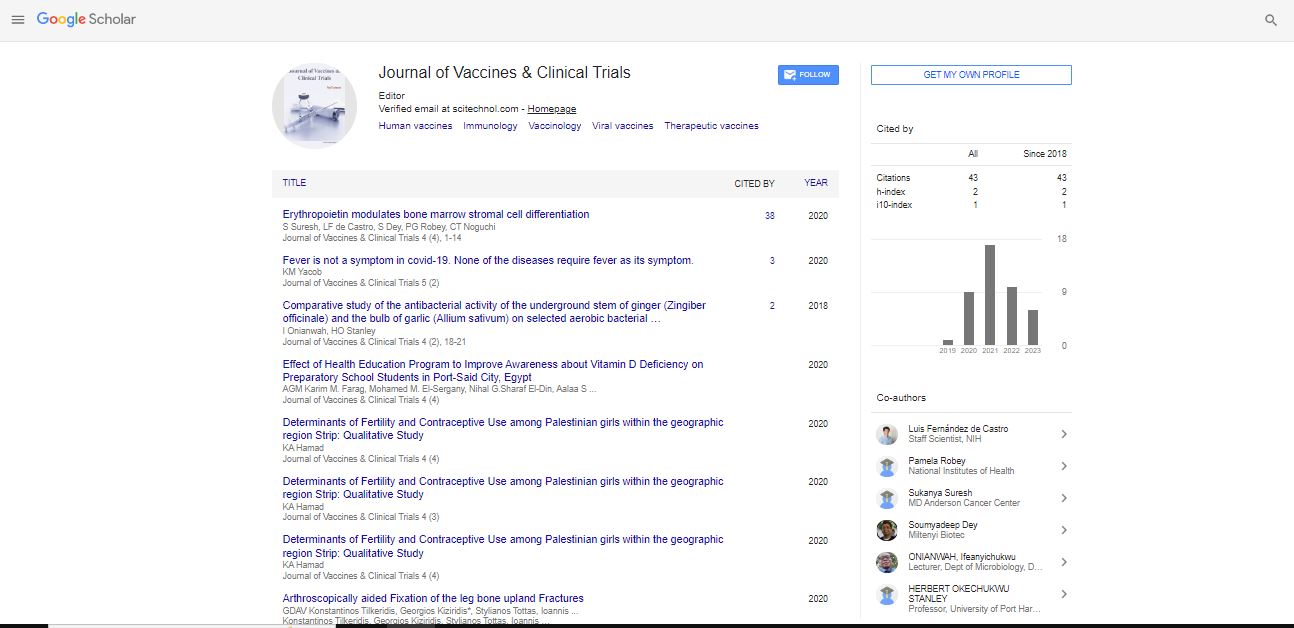Opinion Article, Jou Of Vac Cli Tri Vol: 6 Issue: 1
Importance of Genetic Engineering in Vaccine Production
John Williams*
Department of Microbiology and Clinical Biotechnology,University of Michigan, Michigan, USA
*Corresponding Author: John W
Department of Microbiology and Clinical Biotechnology,University of Michigan,Michigan, USA
Email: williamjohn@gmail.com
Received date: 17 January, 2022, Manuscript No. JVCT-22-48761;
Editor assigned date: 19 January, 2022; PreQC No. JVCT-22-48761 (PQ);
Reviewed date: 29 January, 2022, QC No. JVCT-22-48761;
Revised date: 09 February, 2022, Manuscript No. JVCT-22-48761 (R);
Published date: 15 February, 2022, DOI: 10.4172/JVCT.100051.
Keywords: Genetic Engineering
Introduction
Diseases causing diarrhea are one of the major causes of deaths in low and middle income countries and responsible for high mortality rate in young calves resulting in economic losses. Several studies concluded to the high distribution of Escherichia coli (E. coli) strains in infectious calf diarrhea. STEC causes human gastrointestinal illnesses with diverse clinical spectra. So this study was planned for isolation, identification and molecular characterization of the currently circulating E. coli between calves and related workers in Egypt and to determine the role of virulence genes and Patho types of E. coli in diarrhea in both calves and humans.
The discovery of the Smallpox vaccine by Edward Jenner in 1796 opened the floodgates for further works by scientists on the application of vaccines in infectious disease prevention .These efforts culminated in the discovery of a second vaccine, against diphtheria, which was applied a century later and it would be 150 years for the Polio vaccine to be introduced. Vaccination is one of the fundamental public health achievements of the 20th century and has remarkably decreased the prevalence of infectious disease-related mortalities across the globe. Apart from clean water and sanitation, few public health measures can rival the impact of vaccines which have been widely appraised as a cost effective public health intervention with a population-wide benefit. The successful global eradication of Smallpox and the nearly eradicated Poliovirus is key milestone achievements attributed to vaccination efforts. Vaccines directly induce immunity to confer protection against infections in most vaccinated individuals. They indirectly provide community protection through raised herd immunity by preventing the spread of infectious diseases from person-to-person. A cost-benefit analysis of vaccine-use revealed that for a single birth cohort approximately twenty million cases of diseases were prevented, including 40, 000 mortalities. Vaccination does not only save lives of children but creates a positive impact on the economy. It is estimated that nearly $70 billion in net economic benefit has been attributed to vaccination in the United States. An economic evaluation of 10 vaccines in 94 low-and middle income countries showed that an almost $34 billion investment in immunization program resulted in saving $586 in reducing costs of illness and $1.53 trillion when broader economic benefits were included in the analysis.
Exotoxins of Corynebacterium
The second set of strategies is the inactivated organism or subunit path. Late in the 19th century, Theobald Smith in the United States and Pasteur's colleagues independently showed that whole organisms could be killed without losing immunogenicity, which soon became the basis of vaccines for typhoid and cholera and later for pertussis, influenza, and hepatitis A. In the 1920s, the exotoxins of Corynebacterium diphtheriae and Clostridium tetani were inactivated by formalin to provide antigens for immunization against diphtheria and tetanus. Later in the 20th century, influenza vaccine progressed to subunit preparations, and pertussis vaccine progressed from bacterial soup to the extracted proteins that we use today in acellular vaccines. Extracted native polysaccharides from the capsules of Haemophilus influenzae type b, pneumococci, meningococci, and typhoid bacilli proved useful in immunizing older children and adults, and more recently, the conjugation of these polysaccharides with proteins have provided us with immunogens that generate T cell memory and are effective even in young infants. Although peptide subunits of proteins have not thus far been successful against infectious diseases, they do offer hope for vaccines against melanoma and other cancers, and both lipidated and multiepitope peptides show greater immunogenicity against microbes.
Genetic engineering
There are still many important diseases that are not controlled by vaccination. Why is this so? One reason is that we are now seeking to prevent infections that do not have extracellular, viremic, bacteremic, mucosal or toxemic phases, during which pathogenicity can be neutralized by antibodies in the serum or on the mucosae. Second, although molecular biology permits us to construct just about any antigen, in many cases we know little about the pathogenesis of the target disease and therefore do not know which antigen to choose. More young investigators are needed in the field of pathogenesis.
Nevertheless, molecular biology and its tool, genetic engineering, have now provided additional paths to vaccine development. Although induction of antibodies is still a major goal, a particular aim of much of these efforts is to induce cytotoxic T cell responses and other T cell functions for prevention of diseases in which cellular immunity is crucial.
Knowledge of the base sequences of genes of microbes and the ability to manipulate them has been useful in many ways, starting from DNA, cDNA, or even RNA .Several recombinant strategies are possible. To develop live recombinants, genes from heterotypic viruses can be inserted into an attenuated virus. As examples, to produce a candidate dengue vaccine, the envelope genes from 3 dengue virus serotypes have been inserted into a fourth attenuated serotype .Also, dengue virus genes have been inserted into the attenuated 17D yellow fever virus as a carrier. A candidate West Nile virus vaccine also is based on the 17D carrier.
 Spanish
Spanish  Chinese
Chinese  Russian
Russian  German
German  French
French  Japanese
Japanese  Portuguese
Portuguese  Hindi
Hindi 